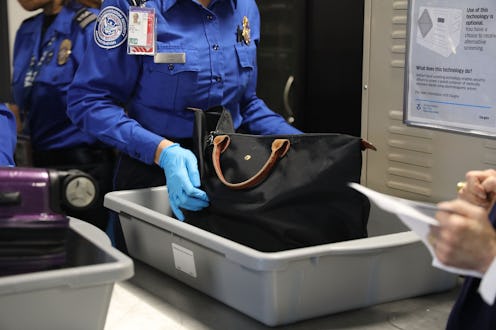Life
The Germiest Place In The Airport Probably Isn’t What You’d Expect

It’s been a bad news week for airplane travel. As if getting through the airport wasn’t stressful enough, now a study has found the germiest place in the airport, right on the heels of news that passengers were quarantined after landing at JFK Airport on Wednesday. (The passengers were ultimately diagnosed with the flu and common cold.)
What takes the top spot for grossest place in the airport? Shockingly, it’s not the airport toilets. According to CNN, experts from the UK’s University of Nottingham and the Finnish National Institute for Health and Welfare found that airport security trays were the biggest hotbeds for germs. Hand sanitizer, anyone?
That’s new information compared to a study released back in February, in which researchers found that airport self-check kiosks were the dirtiest places in the airport. According to Gizmodo, this new study, published in BMC Infectious Diseases, tested 90 commonly touched surfaces at the airport, such as toilet bowl lids, escalator hand rails, elevator buttons, chair armrests, trolley handles, and toys in the children’s play area. The researchers found that the plastic security trays faired the worst, says Gizmodo, with 50 percent containing one of four viruses: the adenovirus, influenza A (the flu), rhinovirus (common cold), and human coronavirus. The researchers say the rhinovirus was the most common virus they found, USA Today reports.
According to Gizmodo, airport security bins are not regularly — or possibly ever — disinfected. The researchers told Gizmodo that the risk of spreading these germs could be significantly decreased if airports provided hand sanitizer to travelers before and after they got through airport security. Also, researchers told Gizmodo, airports should start disinfecting security bins on the regular.
But airport security trays weren’t the only surfaces that contained viruses — they were just the worst offenders. The researchers found high levels of germs on shop payment terminals, staircase rails, passport checking counters, children’s play areas, and in the air itself, CNN reports. Where the researches didn’t find respiratory viruses? The toilet area. According to Gizmodo, the researchers didn’t detect any respiratory viruses on the upper surface of the toilet bowl lids, the flushing buttons, or the locks on the doors. The researchers say passengers probably pay more attention to hygiene in the bathroom than anywhere else in the airport, Gizmodo reports.
"This study supports the case for improved public awareness of how viral infections spread," Jonathan Van Tram, professor of Health Protection from the School of Medicine at the University of Nottingham said in a statement to CNN. "People can help to minimize contagion by hygienic hand-washing and coughing into a handkerchief, tissue, or sleeve at all times, but especially in public places."
The researches also hope that the results of this study can help prevent spreading illnesses while traveling. "These simple precautions can help prevent pandemics and are most important in crowded areas like airports that have a high volume of people traveling to and from many different parts of the world," Van Tam said in a statement to USA Today.
So, how can you help stop the spread of all these germs at the airport? Until airports start providing hand sanitizer at the security line, try to bring your own if you're able to. (You can take it through security if the container's under three fluid ounces.) Otherwise, hit the bathroom as soon as you're through security and wash your hands. The Centers for Disease Control recommends wetting your hands and lathering both sides with soap, and then scrubbing both sides for 20 seconds before rinsing them off. Dry your hands with a clean towel, or let them air dry, says the CDC.
Hearing about all of these germs and illnesses spreading at the airport might sound scary, but knowing how to keep yourself healthy will help you get to your next destination without any issues. Knowing a little about prevention can help keep you from catching the flu or other illness while traveling.